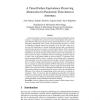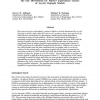1302 search results - page 34 / 261 » Fair Equivalence Relations |
DKE
2008
13 years 7 months ago
2008
In various application domains there is a desire to compare process models, e.g., to relate an organization-specific process model to a reference model, to find a web service matc...
IJFCS
2006
13 years 7 months ago
2006
ion for Parametric Time-Interval Automata Akio Nakata, Tadaaki Tanimoto, Suguru Sasaki, Teruo Higashino Department of Information Networking, Graduate School of Information Science...
AI
2002
Springer
13 years 7 months ago
2002
Springer
Bayesian networks, equivalently graphical Markov models determined by acyclic digraphs or ADGs (also called directed acyclic graphs or dags), have proved to be both effective and ...
ICDCSW
2005
IEEE
14 years 1 months ago
2005
IEEE
Many routing protocols for MANETs do not promote a balanced use of resources among the participating nodes, since they are designed to optimize other criteria, such as the number ...
ICPADS
2006
IEEE
14 years 1 months ago
2006
IEEE
Multi-cluster schedulers can dramatically improve average job turn-around time performance by making use of fragmented node resources available throughout the grid. By carefully m...


